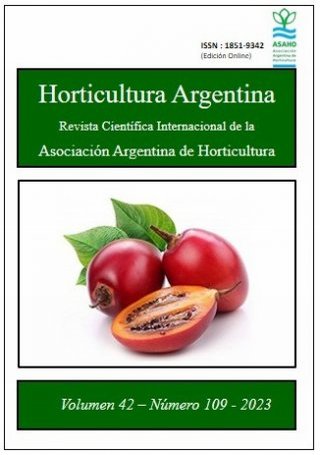Ver ítem
- xmlui.general.dspace_homeCentros Regionales y EEAsCentro Regional Catamarca - La RiojaEEA ChilecitoArtículos científicosxmlui.ArtifactBrowser.ItemViewer.trail
- Inicio
- Centros Regionales y EEAs
- Centro Regional Catamarca - La Rioja
- EEA Chilecito
- Artículos científicos
- Ver ítem
Evaluación en fenología y riego deficitario de Allium sativum L. en La Rioja (Argentina)
Resumen
La agricultura hacia regiones áridas requiere estudios fisiológicos y agronómicos. Seanalizó la fenología y se evaluaron las respuestas morfológicas y productivas del ajo (cv. Morado INTA) a estrategias de riego en una región árida de La Rioja. Se realizó en INTA EEA Chilecito en 2022. El diseño fue en bloques completos al azar con tres repeticiones, se aplicaron tres tratamientos de riego: T1-100%, T2-120% y T3-75% de la Evapotranspiración del cultivo
[ver mas...]
La agricultura hacia regiones áridas requiere estudios fisiológicos y agronómicos. Seanalizó la fenología y se evaluaron las respuestas morfológicas y productivas del ajo (cv. Morado INTA) a estrategias de riego en una región árida de La Rioja. Se realizó en INTA EEA Chilecito en 2022. El diseño fue en bloques completos al azar con tres repeticiones, se aplicaron tres tratamientos de riego: T1-100%, T2-120% y T3-75% de la Evapotranspiración del cultivo (ETc) durante 28 días después de la 12dahoja visible del crecimiento de brote principal. Se utilizó la escala fenológica ampliada del ajo. Se midieron hojas, altura y pseudotallo de la planta y el cuello, disco basal, diámetro, altura y peso del bulbo. Resultados fenológicos: 97,8 % brotación a 19 ddp (días después de plantación) y 368 grados días (GDD), desarrollo del brote principal (12dahoja) a 142 ddp y 1823 GDD y 100% de diámetro de bulbo a 212 ddp y 3095 GDD. Resultados en riego: T3 no afectó altura, número de hojas ni longitud de pseudotallo, pero modificó la hoja basal respecto a T1 y T2. T3 redujo el diámetro de cuello y altura de bulbos sin afectar su peso final, en consecuencia, aumentó el índice de bulbificación respecto a T2.La aplicación del riego deficitario controlado (75% de la ETc) durante el mes de septiembre y el regreso del riego completo hasta la cosecha de bulbos, son estrategias que optimizan el uso de agua y la producción en el cultivo de ajo (cv. Morado INTA).
[Cerrar]
Agriculture in arid regions requires physiological and agronomic studies. Phenology was analysed and morphological and productive responses of garlic (cv.
Morado INTA) to irrigation strategies were evaluated in an arid region of La Rioja. The trial was carried out in INTA EEA Chilecito in 2022. The design was a randomized complete block design with three replications and three irrigation treatments were applied: T1-100%, T2-120% and T3-75% of crop
[ver mas...]
Agriculture in arid regions requires physiological and agronomic studies. Phenology was analysed and morphological and productive responses of garlic (cv.
Morado INTA) to irrigation strategies were evaluated in an arid region of La Rioja. The trial was carried out in INTA EEA Chilecito in 2022. The design was a randomized complete block design with three replications and three irrigation treatments were applied: T1-100%, T2-120% and T3-75% of crop evapotranspiration (ETc) during 28 days after the 12th visible leaf of the main growth stage 1(main shoot). The extended garlic phenological scale was used. Leaves, plant height, plant pseudostem and neck, basal disc, diameter, height and bulb weight were measured. Phenology results: 97.8% sprouting at 19
dap (days after planting) and 368 growing degree-days (GDD), main shoot development (12th leaf) at 142 dap and 1823 GDD and the 100% bulb diameter at 212 dap and 3095 GDD. Irrigation results: T3 did not affect height, number of leaves or pseudostem length, but modified the basal leaf with respect to T1 and T2. T3 reduced neck diameter and bulb height without affecting final bulb weight, and consequently increased the bulbification index with respect to T2. The application of controlled deficit irrigation (75% of ETc) during the month of September and the return to full irrigation until bulb harvest are strategies that optimize water use and production in the garlic crop (cv. Morado INTA).
[Cerrar]

Fuente
Horticultura Argentina 42 (109) : 156-174. (septiembre-diciembre 2023)
Fecha
2023-10
Editorial
Asociación Argentina de Horticultura
ISSN
1851-9342
Documentos Relacionados
Formato
pdf
Tipo de documento
artículo
Proyectos
(ver más)
INTA/2019-PE-E6-I508-001, Diversificación de la oferta varietal de especies hortícolas de uso intensivo
INTA/2023-PD-L01-I127, Mejoramiento genético de hortalizas, ornamentales, aromáticas y medicinales basado en el mercado, en un contexto de intensificación sostenible y cambio climático
Palabras Claves
Derechos de acceso
Abierto
 Excepto donde se diga explicitamente, este item se publica bajo la siguiente descripción: Creative Commons Attribution-NonCommercial-ShareAlike 2.5 Unported (CC BY-NC-SA 2.5)
Excepto donde se diga explicitamente, este item se publica bajo la siguiente descripción: Creative Commons Attribution-NonCommercial-ShareAlike 2.5 Unported (CC BY-NC-SA 2.5)


